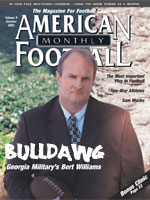AMERICAN FOOTBALL MONTHLY THE #1 RESOURCE FOR FOOTBALL COACHES
Article CategoriesAFM Magazine
|
The Last RepTwo-Way Playersby: Aaron S. Lee © More from this issue Although playing both ways is very rare in college and professional football, coaches are often forced by need to utilize two-way athletes to increase their team’s odds of success. American Football Monthly recently sat down with six of the top college position coaches in the nation that have experience in working with two-way athletes. How do you prepare a two-way athlete in practice? “Usually at the high school level practice is divided into separate offensive and defensive periods, basically because many of the starters play both ways due to the limited resources available. In college, we have to find t....The full article can only be seen by subscribers. Subscribe today!
|
|
|||||||
| HOME |
MAGAZINE |
SUBSCRIBE | ONLINE COLUMNISTS | COACHING VIDEOS |
Copyright 2025, AmericanFootballMonthly.com
All Rights Reserved





